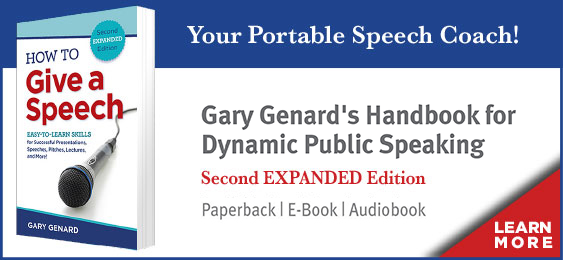
Outstanding presentations are great performances. Here's how to align your message with your delivery skills to inspire and excite audiences.
Did you ever consider that delivering an outstanding presentation is like performing a great song? Not only is the "music" delightful to listen to, but your voice soars on a combination of dynamic technique and an inspirational message. The way you use your vocal tools carriers astonishing weight with regard to credibility, authority, and that all-important attribute, believability.
Why does your voice alone make such a difference? Well, for one thing, we all respond in basic, even primitive ways to the qualities of a person's voice. If a voice is pleasant and authoritative, for instance, it may inspire confidence in the listener. But a voice that comes across as unpleasant, weak, or too timid nudges that same listener in the opposite direction.
Are you more focused on delivering content than moving audiences? Why not combine great material with a dynamic performance? Learn how to establish rapport, own the stage, and gain lasting influence! Download my essential Insights article, Great Speaking? — It's About Performance Over Content!.
Vocal dynamics or vocal variety is one of the most powerful tools you can use to win over an audience. Tone quality, pitch, inflection, emphasis, variety in pace, pauses, and all the emotional nuances your voice can project offer a nearly limitless palette to "paint word pictures" and convince others. When you employ vocal dynamics when you speak, you make your stories and ideas come vibrantly alive for your listeners.

The Potential of Your Voice in Public Speaking
One effective way to realize your vocal potential is simply to keep in mind that the voice is produced physically. That may sound obvious, but it's easy to forget when you're preoccupied with the content of your presentation.
Your voice is intimately connected to breathing, energy and relaxation. So it easily reflects tension and stress. That means that the pressures of a too-hectic lifestyle or professional schedule will emerge in one form or another in your vocal expression. Anything you can do to relieve those pressures—yoga, meditation, sports, or relaxation exercises—will pay off in a more fluid and powerful vocal instrument.
Getting to the Flow of Your Important Message
To be convincing as a speaker and at the same time deliver a dynamic performance, you must combine content and performance. One of the most important ways you can do this is to bring full vocal expressiveness to your message. Beautiful words that don't sound meaningful will not convince people. The converse is true as well: An important message, however passionately delivered, that's phrased clumsily will remain ineffective and perhaps even be viewed as objectionable.
Your content's power and effectiveness hinges on your ability to marry what you're saying to the quality of your voice and other nonverbal cues. When you look and sound good while offering a message worth listening to, all the components will be in place. You will not have to try to be persuasive—you will be persuasive. At that point, the presentation will have a natural flow and audiences will buy into both you and your message. Learn the 5 key tools of vocal dynamics you need to demonstrate for full vocal expressiveness.

Delivering Honesty Is Always Your Job as a Speaker
Once you're aware of the potential of vocal power, you can use the subtleties in your voice to influence audiences. The suppleness of the vocal instrument is a factor presenters too often neglect. The voice is the perfect tool to build trust with stakeholders, to instill confidence in a product or service, to inspire employees, to educate and instruct, and to reassure potential clients or investors.
The key to this power is practice. When you've practiced enough to smoothly use your vocal tools in presentations, remember a last point: Your listeners must trust and respect you. That means you must have an honest conversation with your audience. Be yourself, i.e., speak and move like yourself. Such authenticity looks and sounds like honesty to an audience.
Also, spend time learning how to improve your eye contact with audiences. Look your listeners in the eyes and use your voice to persuade them of your cause. Remember to pay attention to your nonverbal cues and the subtleties of your voice, and convince your listeners by respecting their intelligence and listening to their opinions.
Practice these skills in addition to using your fully expressive voice, and it may be "standing room only" for your next performance.
You should follow me on Twitter here.



